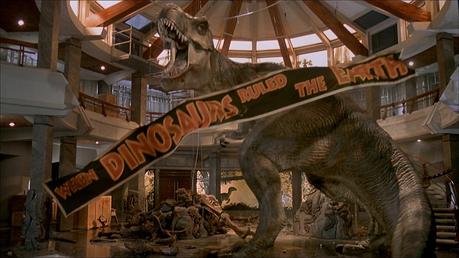On June 11, 1993, Jurassic Park was released, reminding the world of the terrifying might of the Tyrannosaurus Rex.
On May 14, 1992, the world’s largest and most complete Tyrannosaurus Rex fossil was seized by the U.S. federal government, setting off a complicated and prolonged legal custody battle. So, by June 1993 as we were all marveling at Stan Winston’s full-sized mechanical puppet and Phil Tippett’s ground-breaking “go-motion” animated T-Rex the real thing, or at least the bones of one, had been confined to boxes in a holding facility in Rapid City, South Dakota for nearly 13 full months. The world wouldn’t get to see this awe-inspiring artifact of one of the planet’s most legendary predators until May 17, 2000, a year before the release of Jurassic Park 3 by which point pop culture’s post-JP dino-craze had subsided.

In 1990, they found the surefire centerpiece of that museum: a T-Rex which was around 80% in-tact, easily the most complete such specimen in the world. However, they could not have picked a worst spot, legally, to make such a discovery, not that they realized it at the time. They spent over a year excavating Sue back to their facility in Hill City, South Dakota and preparing it for display. The rancher who owned the territory in the Badlands where Sue was discovered was paid five thousand dollars to release legal ownership of the fossil to the Institute. They had no idea that the rancher might not have been legally authorized to make such a deal, and that his land was actually part of Native American territory which was ultimately owned by the federal government.
The Institute thought they owned Sue. The rancher, sensing how much more money he left on the table, reneged and claimed the Institue had hoodwinked him. The Native American government argued the rancher had violated the terms of his land ownership agreement with them by making a sale without first seeking their authorization. Therefore, they thought they were the rightful owners. The federal government thought that, actually, it owned that land, and therefore Sue belonged to them.
That Dinosaur 13 manages to make all of that easy to understand, via some remarkably helpful charts, graphics, and experts offering concise explanation, is but one of its strengths. The documentary’s true strong-point is the way it cuts to the heart of the story: these people had their most amazing dream come true only for it to turn into a living hell. Relationships ended, lifelihoods were ruined, and the financial fate of a small South Dakota town which could have really used a new tourist attraction hung in the balance for nearly a decade. It wasn’t just about Sue, either. Eventually, the federal government wanted to shut the Institute down completely, to make examples out of them in the on-going war between professional and amateur paleontologists.
Even if you don’t give a lick about dinosaurs or dinosaur bones, there is a recognizable and tragic narrative which unfolds across Dinosaur 13. There are even ready-made villains, such as the U.S. District Court Judge who seemed to have a deeply unjust vendetta against the Institute and the acting U.S. Attorney who first seized Sue to, apparently, make a name for himself at the start of what would turn out to be a rather shameful career. That turns figures like Pete Larson, the co-founder of the Institute, into a hero, fighting the good fight against injustice. We see this through recreations using lookalike actors, archival footage from local and national newscasts and present-day interviews with Larson and everyone else involved, all of whom have the looks of people who still can’t quite believed this happened to them.
What Dinosaur 13 lacks, though, is a response from the opposite side of these events. Aside from the lead prosecutor in the case against the Institute and some brief archival soundbites, there is no time given to the other side of the argument. The rancher who reneged on his deal with the Institute died years before the making of Dinosaur 13, but one wishes someone from his family could have been interviewed. Also, in the section of the documentary which transitions from the discussion of Sue to the wider examination of professional vs. amateur paleontologists the representatives of the professional side all ultimately agree with the Institute, i.e., these were not plundering pirates but instead solid paleontologists who were made an example of because they didn’t have PhDs. However, you feel like the documentarians only picked the experts who would help push forward the tragedy narrative, e.g., “These people were screwed for no good reason.”
That being said, it is an undeniably compelling narrative, made all the more captivating by the interviews with Pete Larson and his wife. They actually co-wrote the book which inspired the documentary in the first place. I don’t know enough about the world of paleontology to know if Dinosaur 13 offers a balanced view, but I can recognize the pain that still lingers in the faces of all involved parties. The facts of their case can be easily ingested through a quick Wiki-read, but doing that misses out on the personal side of the story so impressively showcased in Dinosaur 13.
Check CanIStreamIt to see where you can stream/rent/purchase Dinosaur 13.

